Flowability, Tear Strength, and Hydrophilicity of Current Elastomers for Dental Impressions
Abstract
1. Introduction
- price, storability, and shelf life
- patient comfort (e.g., taste, demolding force)
- available viscosities and their flowability during impressions
- compatibility with astringents or disinfectants
- dimensional stability (over time of transport to the dental lab, reset after compression)
- tolerance towards moisture during impression taking and when pouring the cast
- tear strength to avoid ruptures when demolding from the jaw and/or the gypsum cast
- (1)
- Flowability with regard to the competence to reach and copy complex geometries such as subgingival finishing lines or microtopographical surface features [7].
- (2)
- Tear strength when demolding the impression from the jaw after setting time, as well as 24 h later when the impression demolds from the gypsum cast.
- (3)
2. Materials and Methods
2.1. Elastomers under Observation
2.2. Testing of the Flowability
2.3. Testing of the Tear Strength
2.4. Testing of the Hydrophilicity
2.5. Statistical Analysis and Sum Score
3. Results
3.1. Flowability
3.2. Tear Strength
3.3. Hydrophilicity
3.4. Performance Analysis of Light-Body Materials
4. Discussion
4.1. Flowability
4.2. Tear Strength
4.3. Wettability
4.4. Limitations
5. Conclusions
Supplementary Materials
Author Contributions
Funding
Institutional Review Board Statement
Informed Consent Statement
Data Availability Statement
Acknowledgments
Conflicts of Interest
Appendix A
| Year | “Dental” (N Results) | “Impression Material” AND “Dental” (N Results) | Share Out of 1000 Results (‰) |
|---|---|---|---|
| 2010 | 16,001 | 53 | 3.31 |
| 2011 | 18,248 | 44 | 2.41 |
| 2012 | 19,949 | 60 | 3.01 |
| 2013 | 21,386 | 62 | 2.90 |
| 2014 | 23,378 | 62 | 2.65 |
| 2015 | 24,964 | 54 | 2.16 |
| 2016 | 25,290 | 47 | 1.86 |
| 2017 | 25,556 | 45 | 1.76 |
| 2018 | 26,075 | 55 | 2.11 |
| 2019 | 26,871 | 61 | 2.27 |
| 2020 | 30,737 | 49 | 1.59 |
References
- Chochlidakis, K.M.; Papaspyridakos, P.; Geminiani, A.; Chen, C.J.; Feng, I.J.; Ercoli, C. Digital versus conventional impressions for fixed prosthodontics: A systematic review and meta-analysis. J. Prosthet. Dent. 2016, 116, 184–190.e112. [Google Scholar] [CrossRef] [PubMed]
- Flugge, T.; van der Meer, W.J.; Gonzalez, B.G.; Vach, K.; Wismeijer, D.; Wang, P. The accuracy of different dental impression techniques for implant-supported dental prostheses: A systematic review and meta-analysis. Clin. Oral Implants Res. 2018, 29 (Suppl. 16), 374–392. [Google Scholar] [CrossRef] [PubMed]
- Stober, T.; Johnson, G.H.; Schmitter, M. Accuracy of the newly formulated vinyl siloxanether elastomeric impression material. J. Prosthet. Dent. 2010, 103, 228–239. [Google Scholar] [CrossRef]
- Hamalian, T.A.; Nasr, E.; Chidiac, J.J. Impression materials in fixed prosthodontics: Influence of choice on clinical procedure. J. Prosthodont. 2011, 20, 153–160. [Google Scholar] [CrossRef] [PubMed]
- Papadiochos, I.; Papadiochou, S.; Emmanouil, I. The Historical Evolution of Dental Impression Materials. J. Hist. Dent. 2017, 65, 79–89. [Google Scholar]
- Donovan, T.E.; Chee, W.W.L. A review of contemporary impression materials and techniques. Dent. Clin. N. Am. 2004, 48, 445–470. [Google Scholar] [CrossRef]
- German, M.J.; Carrick, T.E.; McCabe, J.F. Surface detail reproduction of elastomeric impression materials related to rheological properties. Dent. Mater. 2008, 24, 951–956. [Google Scholar] [CrossRef] [PubMed]
- Rubel, B.S. Impression materials: A comparative review of impression materials most commonly used in restorative dentistry. Dent. Clin. N. Am. 2007, 51, 629–642. [Google Scholar] [CrossRef] [PubMed]
- Huettig, F.; Chekhani, U.; Klink, A.; Said, F.; Rupp, F. A modified shark-fin test simulating the single-step/double-mix technique: A comparison of three groups of elastomers. Dent. Mater. J. 2018, 37, 414–421. [Google Scholar] [CrossRef] [PubMed]
- DIN. DIN 53504: Testing of Rubber—Determination of Tensile Strength at Break, Tensile Stress at Yield, Elongation at Break and Stress Values in a Tensile Test; Deutsches Insitut für Normung: Berlin, Germany, 2017; Volume DIN 53504, p. 20. [Google Scholar]
- Rupp, F.; Gittens, R.A.; Scheideler, L.; Marmur, A.; Boyan, B.D.; Schwartz, Z.; Geis-Gerstorfer, J. A review on the wettability of dental implant surfaces I: Theoretical and experimental aspects. Acta Biomater. 2014, 10, 2894–2906. [Google Scholar] [CrossRef] [PubMed]
- Schmidt, A.; Klussmann, L.; Wöstmann, B.; Schlenz, M.A. Accuracy of Digital and Conventional Full-Arch Impressions in Patients: An Update. J. Clin. Med. 2020, 9, 688. [Google Scholar] [CrossRef] [PubMed]
- Tolidis, K.; Tortopidis, D.; Gerasimou, P.; Theocharidou, A.; Boutsiouki, C. Comparison of elastomeric impression materials’ thixotropic behavior. Eur. J. Prosthodont. Restor. Dent. 2013, 21, 75–78. [Google Scholar] [PubMed]
- Lawson, N.C.; Cakir, D.; Ramp, L.; Burgess, J.O. Flow profile of regular and fast-setting elastomeric impression materials using a shark fin testing device. J. Esthet. Restor. Dent. 2011, 23, 171–176. [Google Scholar] [CrossRef] [PubMed]
- Hamid, H. Commentary. Flow profile of regular and fast-setting elastomeric impression materials using a shark fin testing device. J. Esthet. Restor. Dent. 2011, 23, 177–178. [Google Scholar] [CrossRef] [PubMed]
- Rupp, F.; Saker, O.; Axmann, D.; Geis-Gerstorfer, J.; Engel, E. Application times for the single-step/double-mix technique for impression materials in clinical practice. Int. J. Prosthodont. 2011, 24, 562–565. [Google Scholar] [PubMed]
- Balkenhol, M.; Wöstmann, B.; Kanehira, M.; Finger, W.J. Shark fin test and impression quality: A correlation analysis. J. Dent. 2007, 35, 409–415. [Google Scholar] [CrossRef] [PubMed]
- Enkling, N.; Bayer, S.; Jöhren, P.; Mericske-Stern, R. Vinylsiloxanether: A new impression material. Clinical study of implant impressions with vinylsiloxanether versus polyether materials. Clin. Implant. Dent. Relat. Res. 2012, 14, 144–151. [Google Scholar] [CrossRef]
- Lawson, N.C.; Burgess, J.O.; Litaker, M. Tear strength of five elastomeric impression materials at two setting times and two tearing rates. J. Esthet. Restor. Dent. 2008, 20, 186–193. [Google Scholar] [CrossRef] [PubMed]
- Pandey, P.; Mantri, S.; Bhasin, A.; Deogade, S.C. Mechanical Properties of a New Vinyl Polyether Silicone in Comparison to Vinyl Polysiloxane and Polyether Elastomeric Impression Materials. Contemp. Clin. Dent. 2019, 10, 203–207. [Google Scholar] [CrossRef] [PubMed]
- Sneed, W.D.; Miller, R.; Olson, J. Tear strength of ten elastomeric impression materials. J. Prosthet. Dent. 1983, 49, 511–513. [Google Scholar] [CrossRef]
- Rupp, F.; Axmann, D.; Jacobi, A.; Groten, M.; Geis-Gerstorfer, J. Hydrophilicity of elastomeric non-aqueous impression materials during setting. Dent. Mater. 2005, 21, 94–102. [Google Scholar] [CrossRef] [PubMed]
- Rupp, F.; Geis-Gerstorfer, J. Hydrophilicity of unset and set elastomeric impression materials. Int. J. Prosthodont. 2010, 23, 552–554. [Google Scholar] [PubMed]
- Rupp, F.; Axmann, D.; Geis-Gerstorfer, J. Effect of relative humidity on the hydrophilicity of unset elastomeric impression materials. Int. J. Prosthodont. 2008, 21, 69–71. [Google Scholar] [PubMed]
- Nassar, U.; Chow, A.K. Surface Detail Reproduction and Effect of Disinfectant and Long-Term Storage on the Dimensional Stability of a Novel Vinyl Polyether Silicone Impression Material. J. Prosthodont. 2015, 24, 494–498. [Google Scholar] [CrossRef] [PubMed]
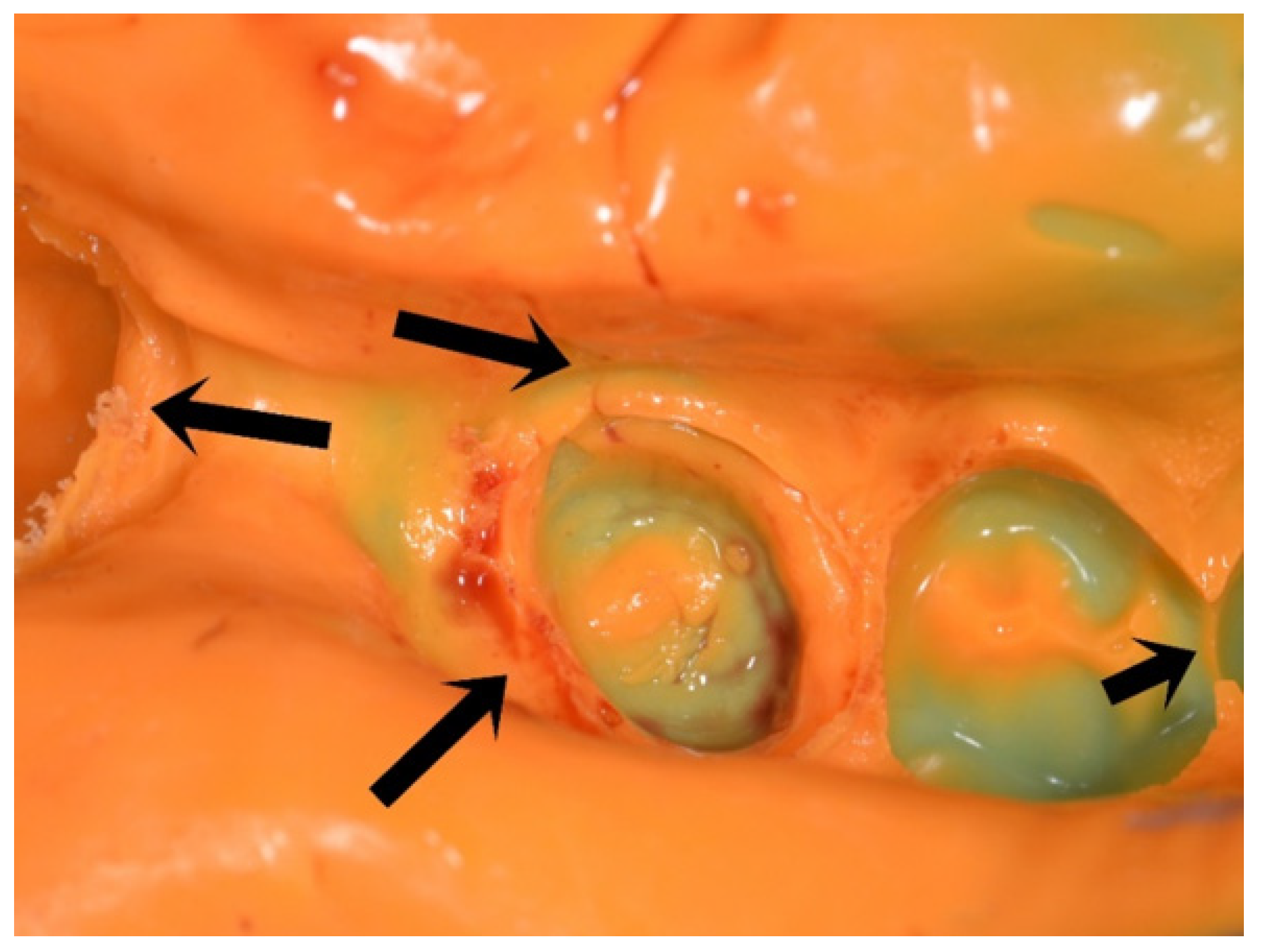
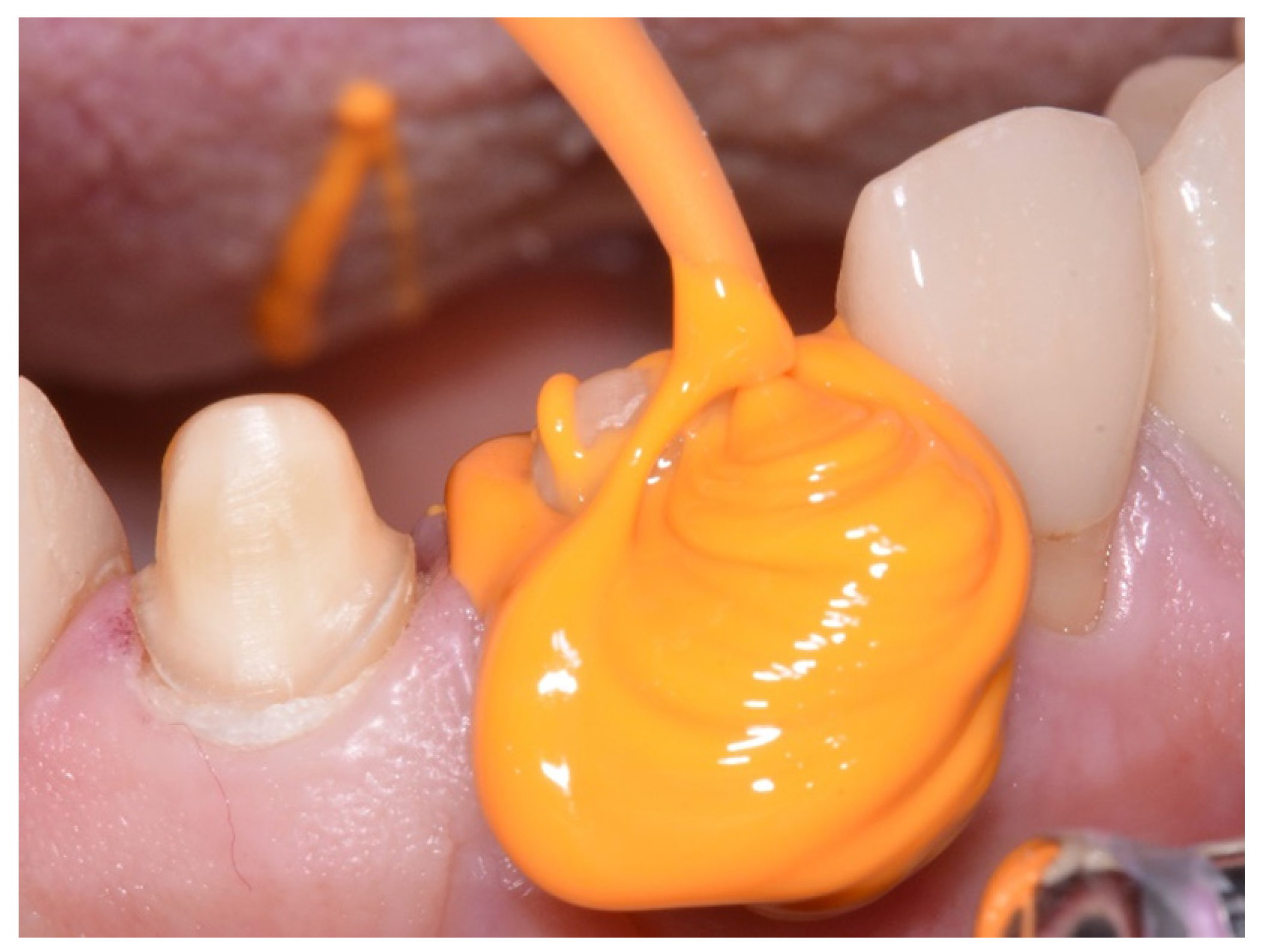
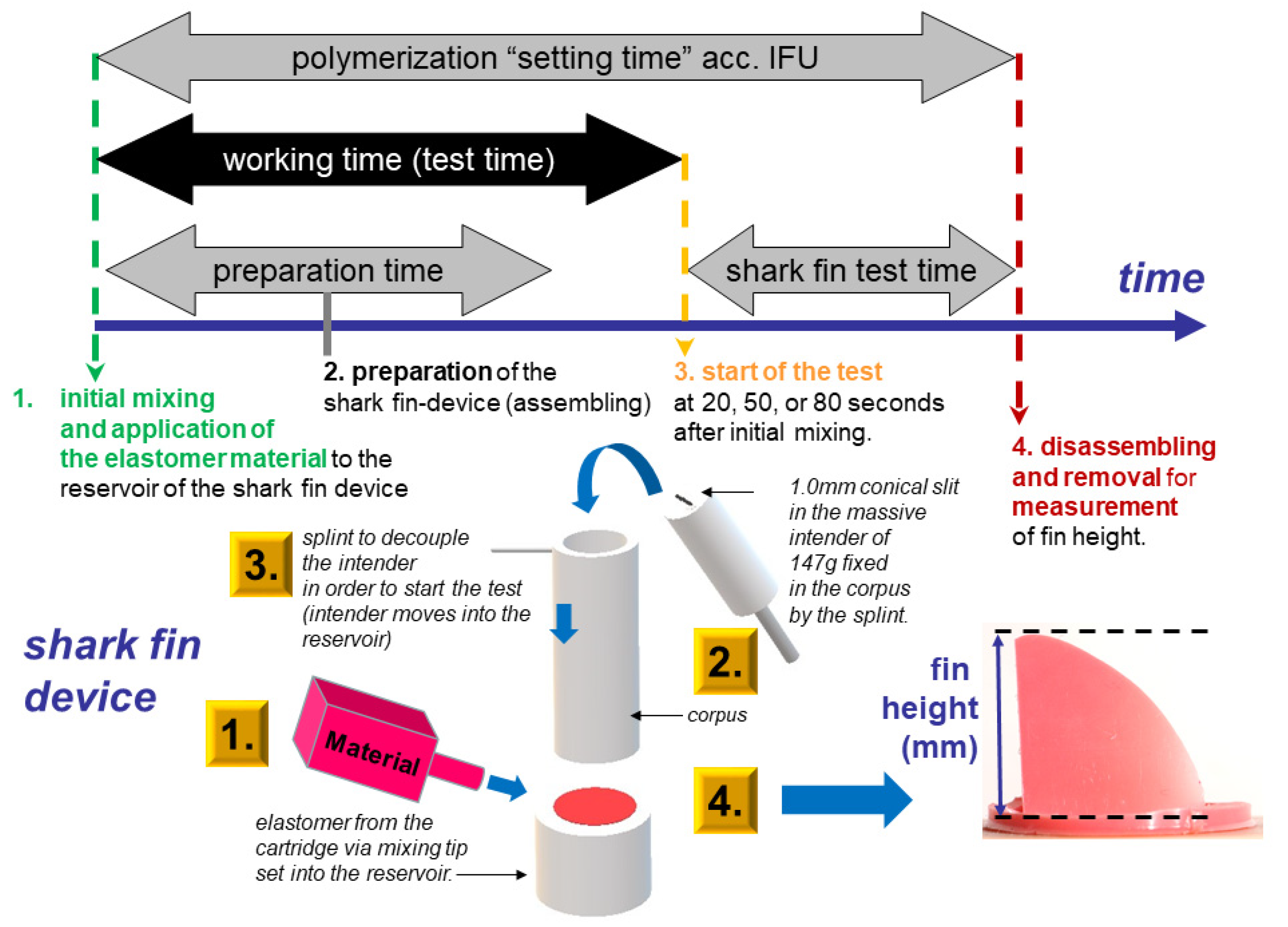
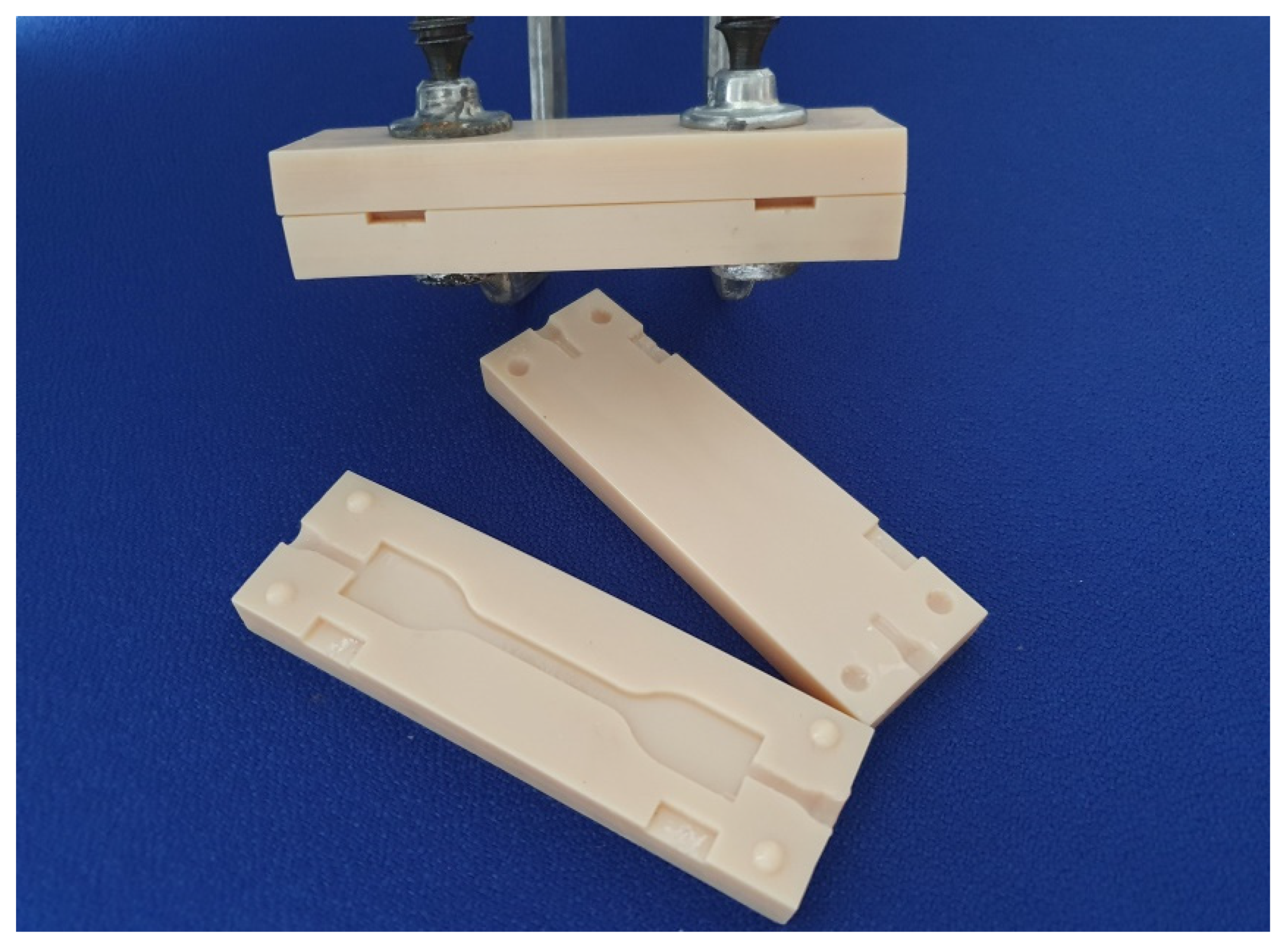
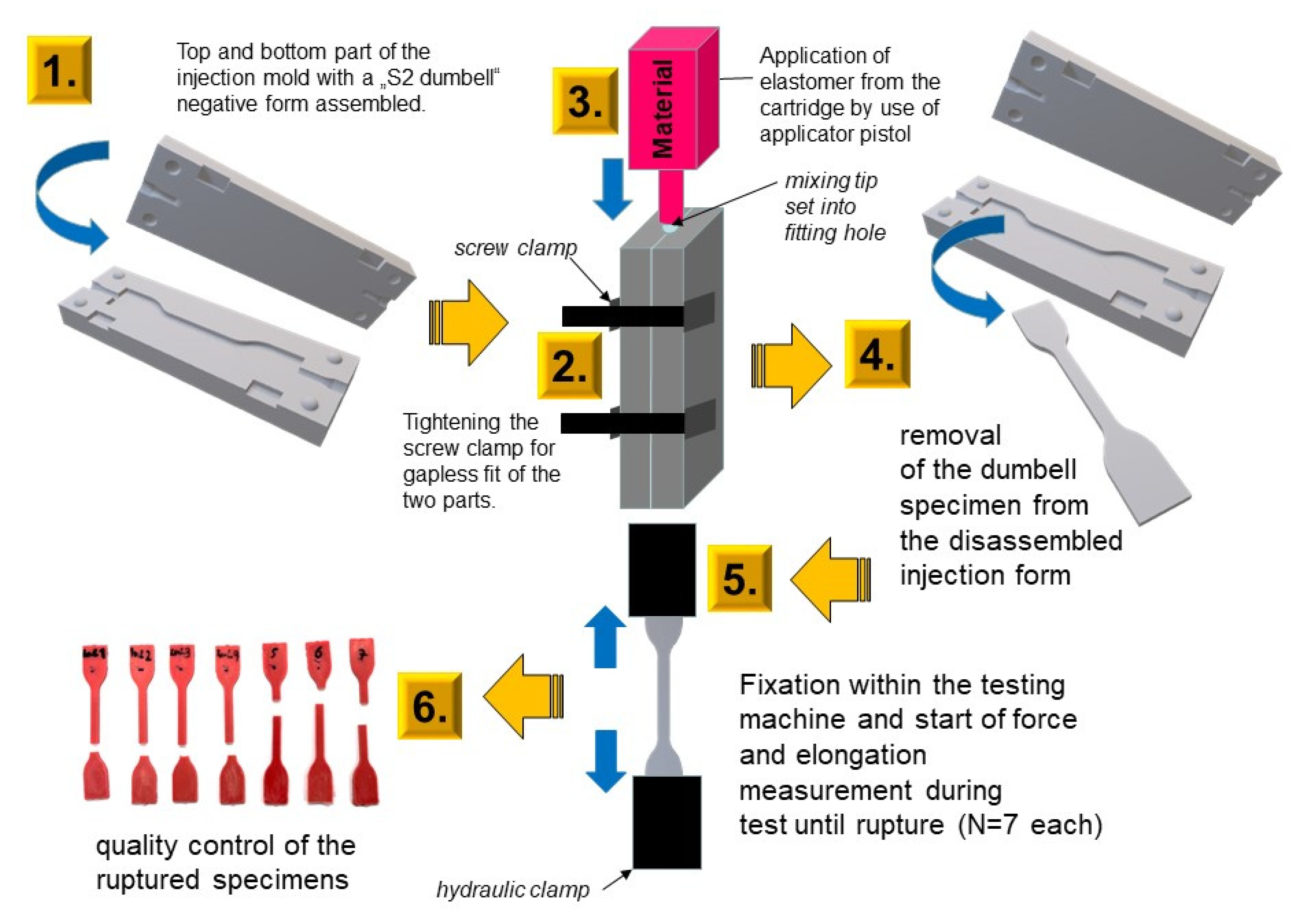
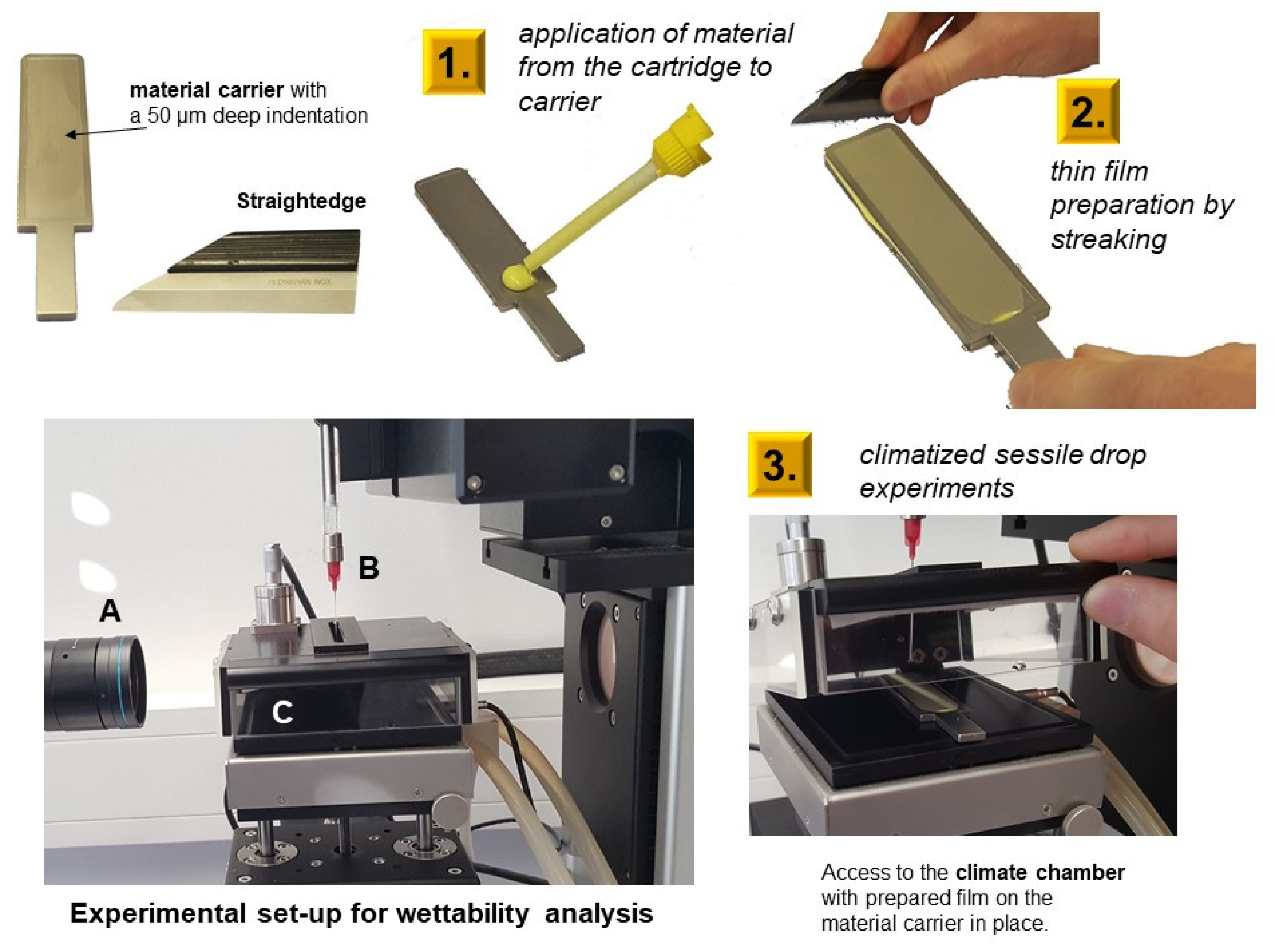


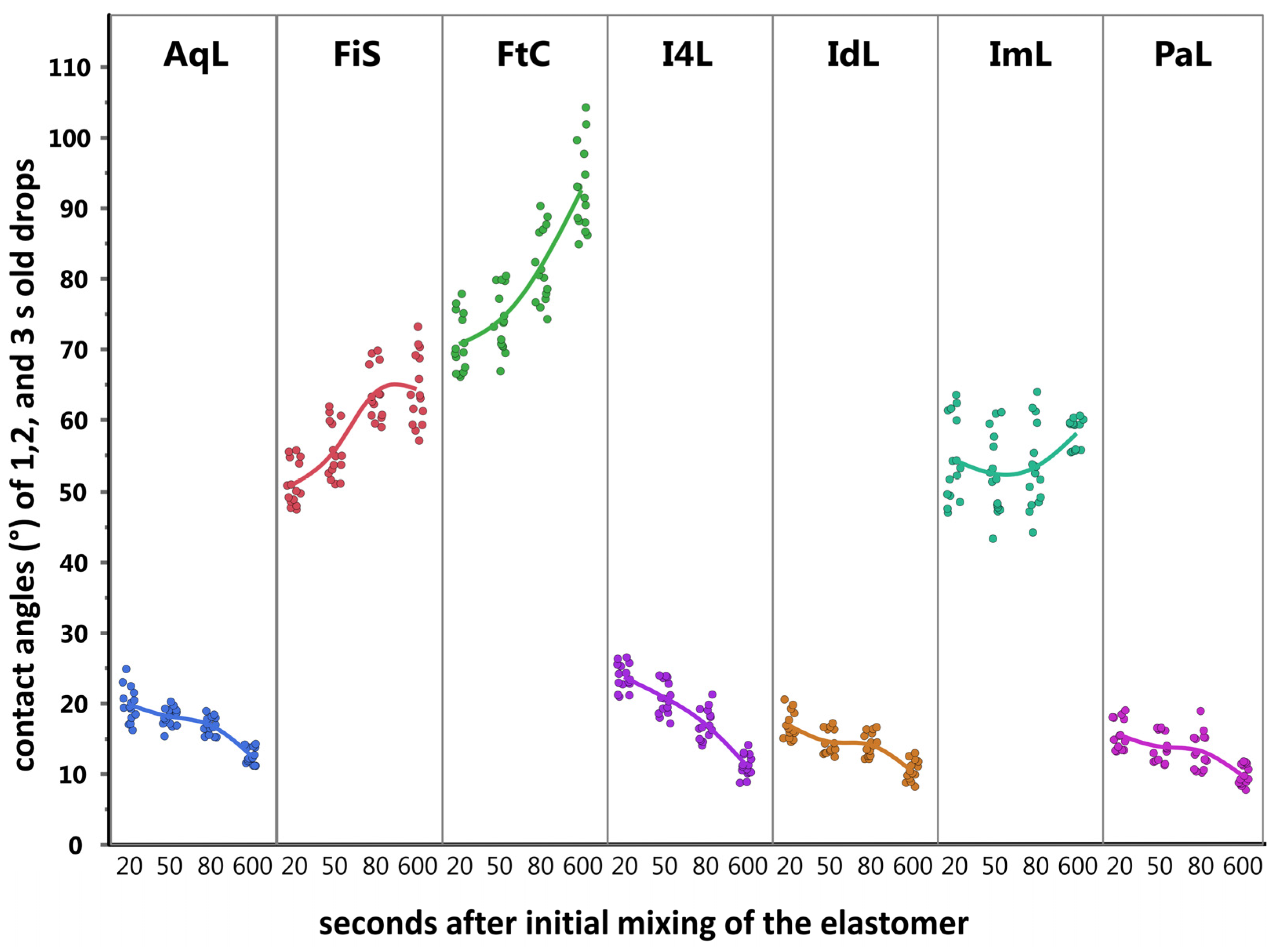
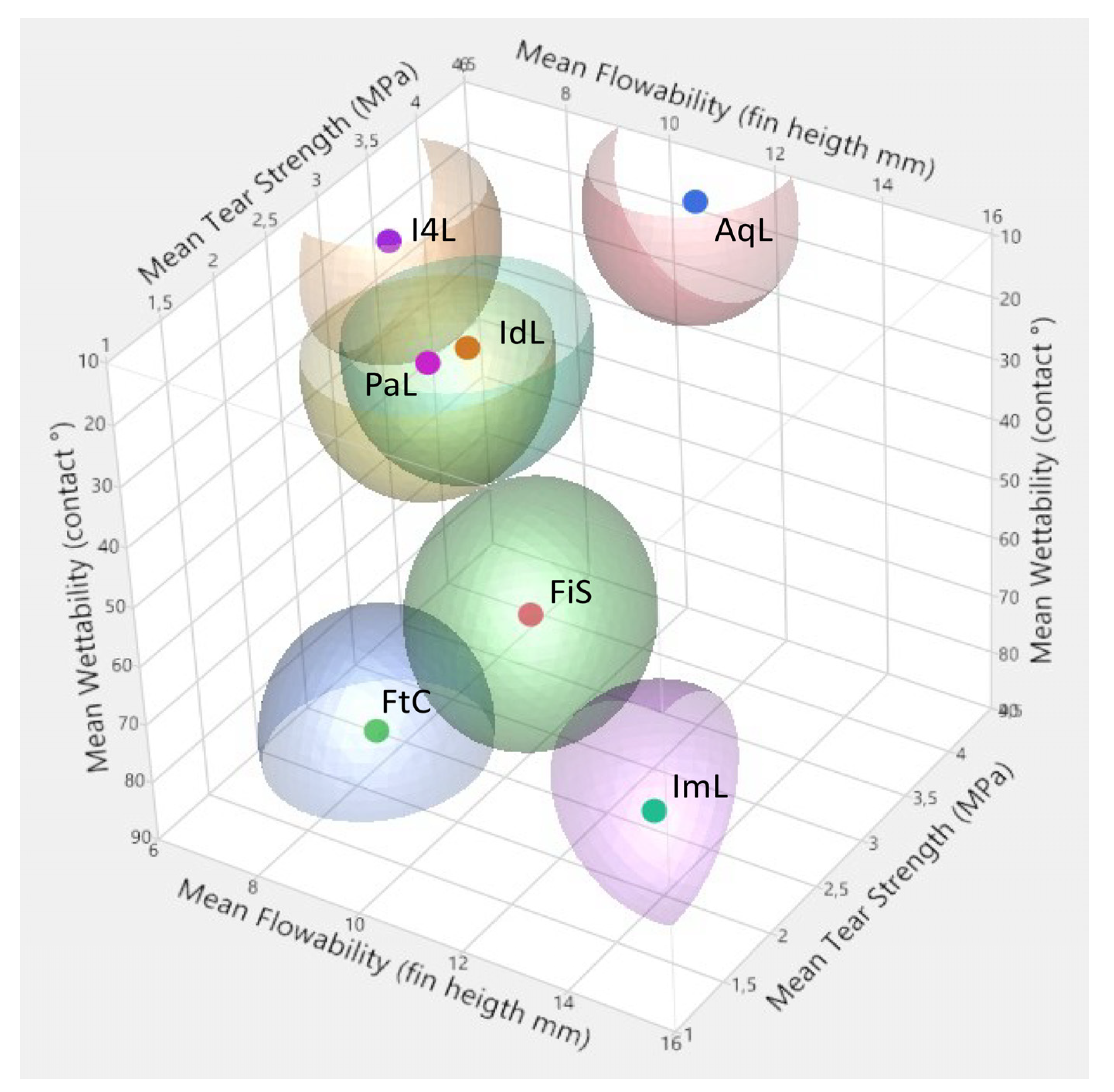
| Material Group | Viscosity | Abbreviation Study Group | Materials Brand Name | Manufacturer | LOT# | Exp. Date Year-Month | Processing Time (s) | Setting Time (s) | Tests |
|---|---|---|---|---|---|---|---|---|---|
| PVS | H | AqH | Aquasil Ultra+ Heavy | Dentsply | 180103 | January 2021 | 135 | 300 | F |
| PVS | L | AqL | Aquasil Ultra+ XLV | 171017 | October 2020 | 135 | 300 | F,T,H | |
| PVS | H | FtH | Flexitime Heavy Tray | Heraeus Kulzer | K010157 | August 2020 | 150 | 150 | F |
| PVS | L | FtC | Flexitime Correct Flow | R010045 | September 2019 | 150 | 150 | F,T,H | |
| PVS | H | PaH | Panasil tray Soft Heavy | Kettenbach | 170591075 | September 2019 | 120 | 240 | F |
| PVS | L | PaL | Panasil Initial contact X-Light | 170701 | May 2020 | 90 | 150 | F,T,H | |
| PVS | H | SyC | Symmetric Comfort | Kaniedenta | 785984 | April 2021 | 105 | 270 | F |
| PVS | L | FiS | Fitnis SH light | 61802062 | March 2021 | 90 | 210 | F,T,H | |
| PVS | H | I4H | Imprint 4 Penta Heavy | 3M ESPE | 3699084 | December 2019 | 120 | 120 | F |
| PVS | L | I4L | Imprint 4 Light | 3944024 | February 2020 | 60 | 120 | F,T | |
| PVS | L | I4L | Imprint 4 Light | 3714170 | December 2019 | 60 | 120 | H | |
| PE | H | ImP | Impregum Penta H Duosoft | 3M ESPE | 3830139 | July 2020 | 150 | 360 | F |
| PE | L | ImL | Impregum Garant L DuoSoft | 3859100, 3737581 | October 2019, August 2019 | 120 | 330 | F,T,H | |
| VSXE | H | IdH | Identium Heavy | Kettenbach | 170541034 | July 2019 | 120 | 270 | F |
| VSXE | L | IdL | Identium Light | 170191, 180211 | February 2019, December 2019 | 120 | 150 | F,T,H |
| Time after Inital Mixing (s) | Light-Body Materials | ||||||||||||||||||||
|---|---|---|---|---|---|---|---|---|---|---|---|---|---|---|---|---|---|---|---|---|---|
| AqL | FiS | FtC | I4L | IdL | ImL | PaL | |||||||||||||||
| Mean | SD | R | Mean | SD | R | Mean | SD | R | Mean | SD | R | Mean | SD | R | Mean | SD | R | Mean | SD | R | |
| 20 | 12.12 | 0.62 | 2 | 15.01 | 0.34 | 1 | 9.45 | 0.45 | 4 | 10.82 | 0.31 | 3 | 10.99 | 0.69 | 3 | 15.59 | 0.62 | 1 | 12.81 | 0.53 | 2 |
| 50 | 10.84 | 0.62 | 2 | 10.35 | 0.39 | 2 | 8.31 | 0.46 | 3 | 6.23 | 0.27 | 5 | 10.18 | 0.51 | 2 | 15.92 | 0.81 | 1 | 9.92 | 0.58 | 3 |
| 80 | 9.04 | 0.25 | 2 | 6.94 | 0.74 | 3 | 7.40 | 0.31 | 3 | 3.51 | 0.20 | 5 | 9.46 | 0.28 | 2 | 15.56 | 0.27 | 1 | 7.29 | 0.39 | 3 |
| average | 10.67 | 1.39 | 2 | 10.77 | 3.42 | 2 | 8.39 | 0.95 | 3.3 | 6.85 | 3.09 | 4.3 | 10.21 | 0.81 | 2.3 | 15.69 | 0.60 | 1 | 10.01 | 2.35 | 2.3 |
| Time after Inital Mixing (s) | Heavy-Body Materials | ||||||||||||||||||||
|---|---|---|---|---|---|---|---|---|---|---|---|---|---|---|---|---|---|---|---|---|---|
| AqH | FtH | I4H | IdH | ImP | PaH | SyC | |||||||||||||||
| Mean | SD | R | Mean | SD | R | Mean | SD | R | Mean | SD | R | Mean | SD | R | Mean | SD | R | Mean | SD | R | |
| 50 | 2.35 | 0.05 | 2 | 0.79 | 0.08 | 6 | 1.80 | 0.08 | 3 | 1.72 | 0.07 | 3 | 5.11 | 0.11 | 1 | 1.07 | 0.08 | 5 | 1.57 | 0.11 | 4 |
| 80 | 1.52 | 0.15 | 2 | 0.48 | 0.07 | 6 | 1.20 | 0.08 | 3 | 0.96 | 0.09 | 4 | 4.98 | 0.08 | 1 | 0.67 | 0.03 | 5 | 0.88 | 0.04 | 4 |
| average | 1.94 | 0.44 | 2 | 0.64 | 0.18 | 6 | 1.50 | 0.32 | 3 | 1.34 | 0.40 | 3.5 | 5.05 | 0.11 | 1 | 0.87 | 0.21 | 5 | 1.23 | 0.36 | 4 |
| Time after Inital Mixing (s) | Corresponding Materials | ||||||||||||||||||||
|---|---|---|---|---|---|---|---|---|---|---|---|---|---|---|---|---|---|---|---|---|---|
| AqH-AqL | FtH-FtC | I4H-I4L | IdH-IdL | ImP-ImL | PaH-PaL | SyC-Fis | |||||||||||||||
| Mean | SD | R | Mean | SD | R | Mean | SD | R | Mean | SD | R | Mean | SD | R | Mean | SD | R | Mean | SD | R | |
| 50 | 10.04 | 0.50 | 3 | 8.22 | 0.98 | 4 | 7.71 | 0.32 | 5 | 9.43 | 1.33 | 3 | 16.43 | 0.46 | 1 | 9.96 | 1.25 | 3 | 11.87 | 1.21 | 2 |
| 80 | 8.97 | 0.32 | 2 | 8.12 | 0.59 | 2 | 4.55 | 0.17 | 4 | 8.56 | 0.84 | 2 | 15.66 | 0.63 | 1 | 7.02 | 0.69 | 3 | 6.75 | 0.70 | 3 |
| average | 9.50 | 0.69 | 2.5 | 8.17 | 0.78 | 3 | 6.13 | 1.65 | 4.5 | 8.99 | 1.16 | 2.5 | 16.04 | 0.66 | 1 | 8.49 | 1.80 | 3 | 9.31 | 2.81 | 2.5 |
| Material | T0 | T24 | T0 | T24 | T0 | T24 | ||||||||||||
|---|---|---|---|---|---|---|---|---|---|---|---|---|---|---|---|---|---|---|
| σ50 (MPa) | σ50 (MPa) | eR (in %) | eR (in %) | σmax (MPa) | σmax (MPa) | |||||||||||||
| Mean | Std Dev | R | Mean | Std Dev | R | Mean | Std Dev | R | Mean | Std Dev | R | Mean | Std Dev | R | Mean | Std Dev | R | |
| AqL | 0.75 | 0.12 | 2 | 1.92 | 0.17 | 1 | 197 | 28.41 | 1 | 108.95 | 8.85 | 3 | 3.72 | 0.39 | 1 | 5.05 | 0.32 | 1 |
| FiS | 0.78 | 0.05 | 2 | 1.20 | 0.08 | 4 | 171 | 39.23 | 1 | 116.99 | 9.85 | 2 | 2.30 | 0.29 | 3 | 2.64 | 0.12 | 3 |
| FtC | 0.65 | 0.04 | 2 | 0.68 | 0.04 | 5 | 201 | 25.35 | 1 | 183.96 | 28.91 | 1 | 2.07 | 0.23 | 3 | 2.03 | 0.19 | 4 |
| I4L | 1.35 | 0.08 | 1 | 1.66 | 0.09 | 2 | 118 | 5.77 | 2 | 102.60 | 8.37 | 3 | 3.00 | 0.18 | 2 | 3.49 | 0.14 | 2 |
| IdL | 1.38 | 0.25 | 1 | 1.44 | 0.05 | 3 | 122 | 25.69 | 2 | 117.13 | 9.39 | 2 | 2.21 | 0.26 | 3 | 2.40 | 0.07 | 3 |
| ImL | 0.52 | 0.10 | 3 | 1.15 | 0.09 | 4 | 116 | 36.71 | 2 | 85.58 | 19.80 | 3 | 0.75 | 0.14 | 5 | 1.41 | 0.14 | 5 |
| PaL | 0.81 | 0.17 | 2 | 1.18 | 0.06 | 4 | 179 | 33.03 | 1 | 137.41 | 14.67 | 2 | 1.82 | 0.27 | 4 | 2.21 | 0.09 | 4 |
| Material | Time after Initial Mixing (s) | ||||||||||||
|---|---|---|---|---|---|---|---|---|---|---|---|---|---|
| 20 | 50 | 80 | 600 + Setting Time | ||||||||||
| Contact Angle (°) | Contact Angle (°) | Contact Angle (°) | Contact Angle (°) | ||||||||||
| Mean | Std Dev | R | Mean | Std Dev | R | Mean | Std Dev | R | Mean | Std Dev | R | Mean R | |
| AqL | 19.76 | 2.40 | 2 | 18.01 | 1.30 | 2 | 16.82 | 1.22 | 2 | 12.42 | 1.17 | 2 | 2 |
| FiS | 50.97 | 3.08 | 3 | 55.64 | 3.91 | 4 | 64.04 | 3.92 | 4 | 64.33 | 5.05 | 4 | 3.75 |
| FtC | 70.75 | 4.05 | 4 | 74.11 | 4.36 | 5 | 81.64 | 5.17 | 5 | 92.53 | 5.97 | 5 | 4.75 |
| I4L | 23.62 | 1.86 | 2 | 20.69 | 2.32 | 3 | 16.94 | 2.15 | 2 | 11.10 | 1.53 | 2 | 2.25 |
| IdL | 16.80 | 1.89 | 1 | 14.42 | 1.67 | 1 | 14.05 | 1.62 | 1 | 10.30 | 1.48 | 1 | 1 |
| ImL | 54.38 | 5.89 | 3 | 52.35 | 5.62 | 4 | 53.32 | 5.96 | 3 | 58.09 | 2.10 | 3 | 3.25 |
| PaL | 15.47 | 2.10 | 1 | 13.75 | 2.03 | 1 | 13.18 | 2.55 | 1 | 9.74 | 1.39 | 1 | 1 |
| Elastomer | Flowability * | Hydrophilicity | Tear Strength | Sum Score (Final Rank) |
|---|---|---|---|---|
| AqL | 2.17 | 2 | 1.5 | 5.67 (1) |
| IdL | 2.77 | 1 | 2.33 | 6.10 (2) |
| PaL | 3.43 | 1 | 2.83 | 7.26 (3) |
| ImL | 1 | 3.25 | 3.66 | 7.91 (4) |
| I4L | 3.93 | 2.25 | 2 | 8.18 (5) |
| FiS | 2.83 | 3.75 | 2.5 | 9.08 (6) |
| FtC | 4.1 | 4.75 | 2.67 | 11.52 (7) |
Publisher’s Note: MDPI stays neutral with regard to jurisdictional claims in published maps and institutional affiliations. |
© 2021 by the authors. Licensee MDPI, Basel, Switzerland. This article is an open access article distributed under the terms and conditions of the Creative Commons Attribution (CC BY) license (https://creativecommons.org/licenses/by/4.0/).
Share and Cite
Huettig, F.; Klink, A.; Kohler, A.; Mutschler, M.; Rupp, F. Flowability, Tear Strength, and Hydrophilicity of Current Elastomers for Dental Impressions. Materials 2021, 14, 2994. https://doi.org/10.3390/ma14112994
Huettig F, Klink A, Kohler A, Mutschler M, Rupp F. Flowability, Tear Strength, and Hydrophilicity of Current Elastomers for Dental Impressions. Materials. 2021; 14(11):2994. https://doi.org/10.3390/ma14112994
Chicago/Turabian StyleHuettig, Fabian, Andrea Klink, Alexander Kohler, Moritz Mutschler, and Frank Rupp. 2021. "Flowability, Tear Strength, and Hydrophilicity of Current Elastomers for Dental Impressions" Materials 14, no. 11: 2994. https://doi.org/10.3390/ma14112994
APA StyleHuettig, F., Klink, A., Kohler, A., Mutschler, M., & Rupp, F. (2021). Flowability, Tear Strength, and Hydrophilicity of Current Elastomers for Dental Impressions. Materials, 14(11), 2994. https://doi.org/10.3390/ma14112994







